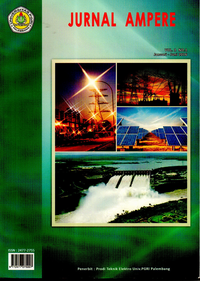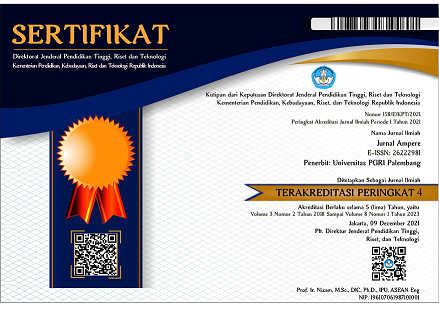Rancang Bangun Sistem Otomatisasi dan Telekontrol Pada Pengkondisian Air Kolam Pembibitan Ikan Nila
DOI:
https://doi.org/10.31851/ampere.v6i1.5981Keywords:
Tilapia, Automation, Temperature Sensors, Height Sensors, Water Clarity SensorsAbstract
The needs of Tilapia is quite high and popular for that the needs of this fish increasingly every year. The needs of tilapia should be support also by the availability of its seeds which determan by the ponds water conditions such as temperature, water clarity and its height. This research designs a prototype of a system to maintain the optimum temperature condition in the range of 25°-30° celcius for tilapia seeds pond. When the system indicate that the water temperature hits 25oC or below, it activate the heater to heat the water pond until it reach the temperature of 28oC. The fish seeds develop well for the water height between 40-60 cm. When the water is too high so the system will activate the pump to drain the pond to the normal level, otherwise the pump will fill the pond whenever the system indicate the water level in the pond is low. The best water for tilapia seeds is a pond with clear and clean water. The the water pond indicate to be muddy it also activate the pump to drain water to the low level and fill it again to the normal level. This simulation results show that the prototype of automation of water conditioning controller has work properly to  drain, to fill, to clarify, to warm the water pond automatically and able to send messages to the user about those condition. Â
Abstrak
Ikan nila adalah salah satu jenis ikan yang bernilai ekonomis tinggi sehingga kebutuhan benih maupun ikan yang layak cenderung meningkat setiap tahunnya. Seiring meningkatnya permintaan ikan maka harus diiringi dengan penyedian benih ikan yang berkualitas, di mana hal ini sangat ditentukan oleh kondisi air kolam seperti suhu, kejernihan dan ketinggian air. Penelitian ini membuat rancang bangun suatu sistem yang mengatur kondisi suhu optimal untuk kolam pembibitan ikan yaitu 25°-30° celcius. Apabila suhu air kolam dibawah 25° celcius maka sistem mengaktifkan heater sampai pada suhu 28° celcius. Untuk ketinggian air yang baik untuk kolam pembibitan adalah berkisar antara 40-60 centimeter. Penelitian ini mensimulasikan tiga level ketinggian yaitu rendah, normal, dan tinggi. Pada saat air berada pada kondisi level air tinggi maka pompa pengurasan aktif hingga ketinggian air sampai pada level normal yang akan menghentikan pompa. Selanjutnya pada saat level air rendah, maka pompa akan mengisi kolam hingga pada level normal yang akan menghentikan kerja pompa. Untuk kejernihan air, kondisi yang diharapkan adalah air yang jernih dan bersih. Pada saat air keruh maka pompa pengurasan akan aktif sampai batas level rendah kemudian melakukan pengisian kembali sampai batas normal. Hasil simulasi penelitian ini memperlihatkan bahwa rancang bangun prototipe otomatisasi kontrol pengkondisian air, sudah dapat melakukan pengurasan, pengisian, penjernihan dan penghangatan otomatis serta mampu mengirim pesan pada pengguna.
References
DIO RHEZA RIVANDI, “Pemeliharaan Induk Dan Larva Ikan Nila,†2014.
Anonim, “Panduan lengkap budidaya ikan nila.†http://alamtani.com/budidaya-ikan-nila.html .
Anonim, “Mengatur Ketinggian Air Kolam Nila,†2016. .
Pakan Alternatif Ternak, “No Title.â€
https://pakanalternatiflele.wordpress.com/author/pakanalternatiflele/.
R. . Aldaka, “Sistem Otomatisasi Pengkondisian Suhu, pH,dan Kejernihan Air Kolam Pada Pembudidayaan Ikan Patin,†2015.
PPPPTK BOE Malang, Modul pengembangan keprofesian berkelanjutan (PKB) berbasis kompetensi. 2018.
M. B. Ridwan, “Sistem Monitoring Tanaman Hidroponik Dengan Sensor PH , Suhu Air Dan Pemupukan Berbasis Internet of Thing,†J. TeknoSains FTIE UTY, 2019.
R. Yuliawiata, “Prototipe Sistem Ketinggian Dan Debit Air Pada Sungai Berbasis Mikrokontroler16,†Tek. Inform. Univ. Islam Negri Sunan Kalijaga., 2013.
.
Downloads
Published
How to Cite
Issue
Section
License

Jurnal Ampere is licensed under a Creative Commons Attribution-ShareAlike 4.0 International License.
Authors who publish with this journal agree to the following terms:
- Authors retain copyright and grant the journal right of first publication with the work simultaneously licensed under a Creative Commons Attribution License that allows others to share the work with an acknowledgement of the work's authorship and initial publication in this journal.
- Authors are able to enter into separate, additional contractual arrangements for the non-exclusive distribution of the journal's published version of the work (e.g., post it to an institutional repository or publish it in a book), with an acknowledgement of its initial publication in this journal.
- Authors are permitted and encouraged to post their work online (e.g., in institutional repositories or on their website) prior to and during the submission process, as it can lead to productive exchanges, as well as earlier and greater citation of published work.






